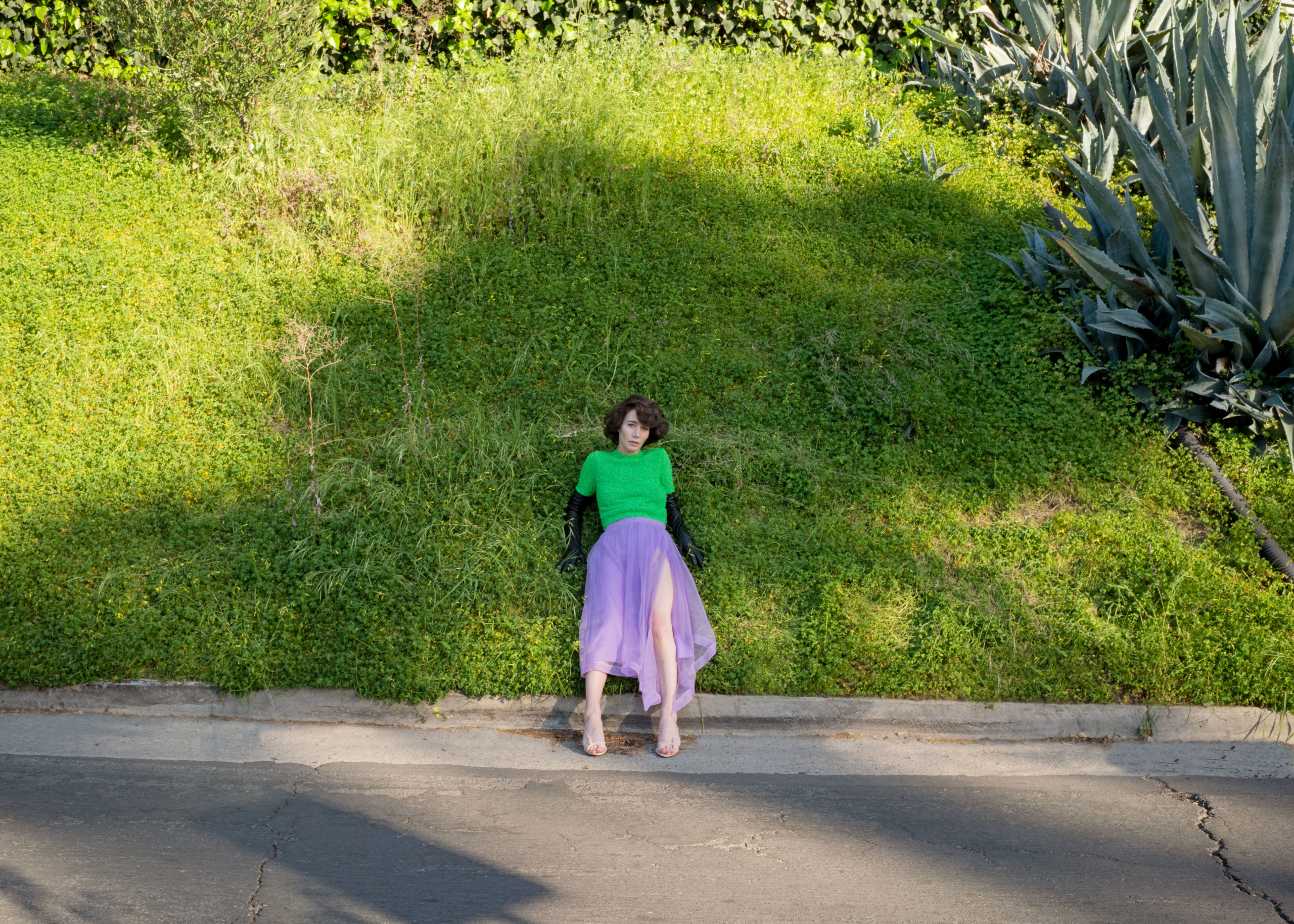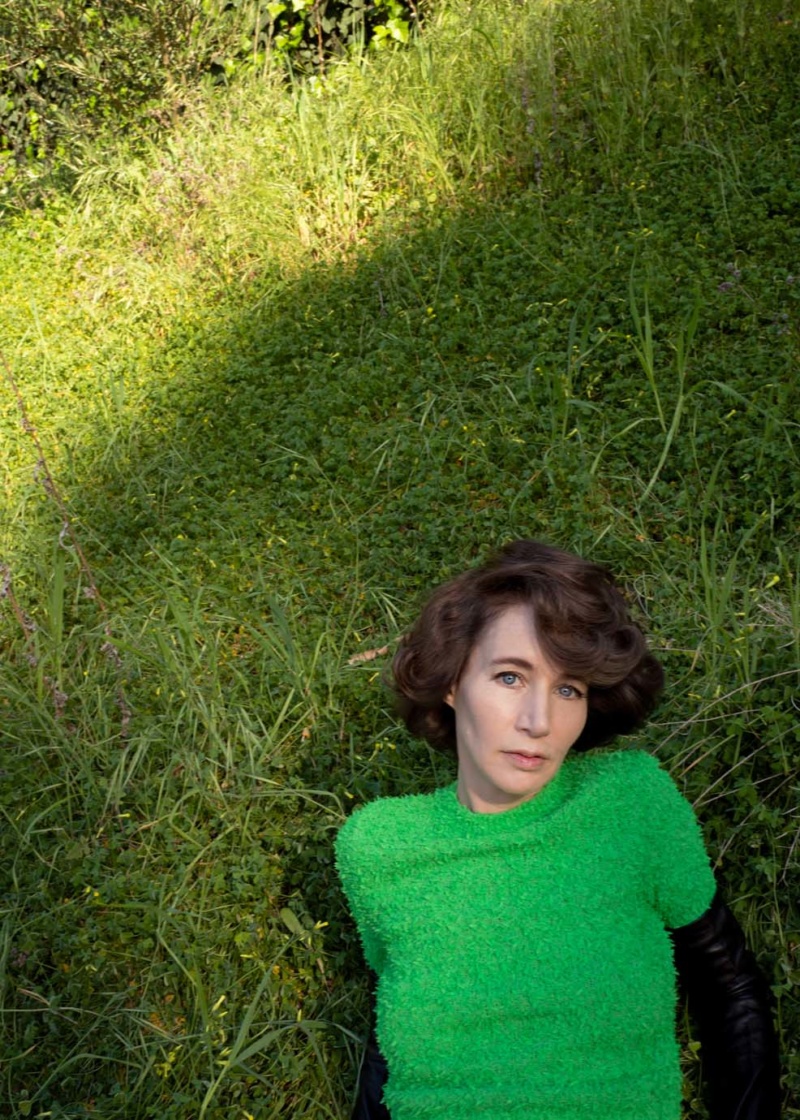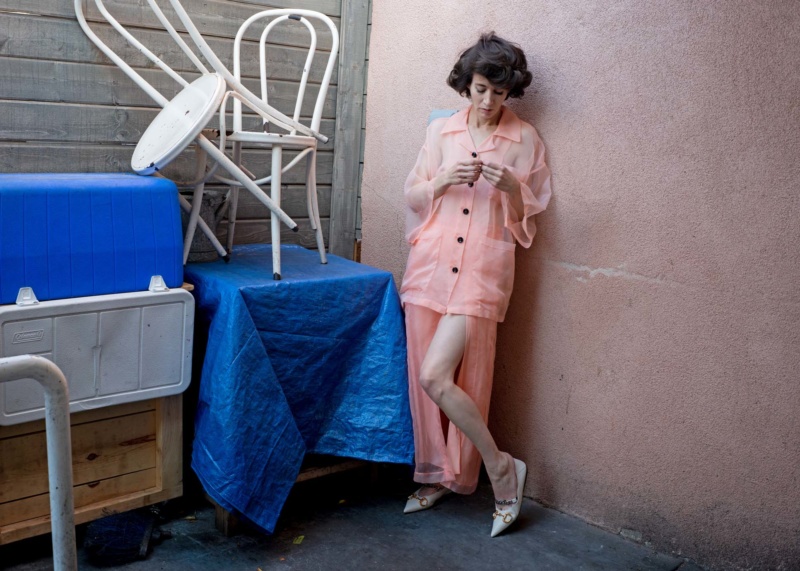
SOKO: I’ve been cherishing this book. It’s really crazy. How long did it take you to put together?
MJ: I started it before my movie [Kajillionaire (2020)], stopped to make the movie, and then, all last summer, I almost killed myself finishing it in time.
SOKO: When did you get the idea?
MJ: Probably in 2016 or ’17.
SOKO: It must have taken years to get all of this information together. Are you a hoarder?
MJ: I hope not. I don’t think I’m a hoarder; I think I’m an archiver. I do keep all my letters, for example. I have every letter I have gotten since I was six.
SOKO: Whoa.
MJ: And certainly every costume from every performance, every piece of equipment, every note from every project. I’m really not this grandiose, but, as I explain in the book, it was something my dad did, so I started as a child and as a teenager and then it seemed arbitrary to stop.
SOKO: Where is all of this material stored?
MJ: I have a two-bedroom house—that’s my studio—in Echo Park. I have a whole room and it’s overflowing. I am hitting a point where I have to decide what I’m doing.
SOKO: Now that it’s all in the book, and you’ve made something with it that will last in a distilled form, will it be easier to let go?
MJ: I won’t let it go. But it might go to a place that keeps artists’ archives. For example, my “Joanie 4 Jackie” project went to the Getty. Usually you look into these things when you’re going to die, which hopefully isn’t right now.
SOKO: This makes me think about what’s missing in this book—
MJ: So much.
SOKO: Everything that came before. I’m wondering who you were as a kid: what did you want to do when you were five, when you were fifteen? What was your ideal job?
MJ: I probably wanted to be Annie. I probably wanted to be a singing, dancing actress—like you. I think that’s what’s available to little girls, you know?
SOKO: Yeah.

MJ: That’s actually one of the few powerful, magical roles that belongs to little girls. I know my friend Monet Zulpo-Dane has a couple quotes in the book about this. I wrote a play for us in second grade (that I also directed and acted in) and I think of that as the beginning, but the book doesn’t go that far back because that would have been ridiculous.
SOKO: There’s a lot more space now for multi-hyphenate artists. But, when you started, and being so naturally multitalented and multidisciplinary, were people trying to make you be just one thing? How did you prove, “I can do all these things”?
MJ: It’s funny to remember how much that was an issue. One of the Bauhaus artists, László Moholy-Nagy, wrote about how specialization was evil and being able to do everything was the natural state. I don’t know how I came across that book but I still have it with all the little bookmarks in it. It was very validating to me. I think it was important that I did a lot of different things for a long time before my first movie. By the time that I had that bigger success, I had already planted the seed of who I was.
I remember all these offers afterwards saying, “you can go immediately into a first look [movie] deal with this company” and me being like, “no, if I don’t put out my book of short stories then I will forever be this indie filmmaker and I’m not that.” Being an indie filmmaker is cool but that’s not exactly what I’ve been doing all these years. It felt really important to make that strong turn—to continue with what I was doing, even if other people didn’t fully understand it. After that book of stories came out, No One Belongs Here More Than You (2005), it became a lot easier. If you’re two things, people stop counting at that point. It doesn’t matter if you’re three or four, you’ve already misaligned yourself with the industry.
SOKO: I talk movies and music in every one of my own interviews. To this day, people still ask me, “what do you prefer?” But it’s all essential to who I am. I love collaborating with people. I love telling stories. I love being in movies and becoming someone else. But I also love making music. That’s when I’m fully myself. Music is more self-centered in a way that makes me realign with who I really am, and I need that balance.
MJ: That question is always a giveaway that the person doesn’t understand you. It’s like saying, “what do you prefer: eating or sleeping?”
More recently, I’ve thought these divisions are totally external. We are holistic beings and that shift will need to come in people’s perspectives. It’s kind of like people realizing that all the bacteria in your gut is important for health, and not the enemy. It’s like realizing that the more you divide yourself, or treat parts of yourself as “not the main thing,” the more you’re missing the whole of who you are.
SOKO: Reading this book felt like watching a documentary. Did you ever think about making a documentary out of all of this? I’m not much of a reader. It’s hard for me to read because I have terrible ADD and a young baby who is demanding of my every waking hour. But I love watching documentaries—I’m a very visual person. I wanted to hear the voices of your friends sharing their testimonies. I wanted to see their faces. I wanted to see snippets of your performances.
MJ: Well, gosh. I thought I was done. It never really occurred to me, although, you’re right, there’s just as much visual material. I’m honored that you read it against those odds—against ADD and a baby.
SOKO: What do you miss most about being a child? As an artist, you have a very lively inner child, and it seems like everything for you is about play.
MJ: I don’t miss my particular childhood. It’s funny—last night, [my son] Hopper was spiraling out before bed and not wanting to go to school tomorrow. He was saying, “you get to choose what you want to do and I just have to do this thing forever.” I said the wrong thing, which was, “I know it sucks, I’m so sorry.”
SOKO: What was the right thing to say?
MJ: Maybe not something so depressing. After that, I said something like, “You don’t know exactly how every day is going to go and there are surprises each day.” I remember when I was newly an adult, still waking up every day thinking, “it’s just so wonderful that I get to decide.” I think that’s all I ever wanted.
SOKO: I wanted to move out of my house by age ten. My mom would say, “if you’re not doing this or this, I’m going to send you to boarding school” and I was like, “yes, that’s a great idea. Please send me away.” I left home at fifteen, ready to start working. I am my own person. I have my own thoughts.
MJ: Fifteen, wow.
SOKO: I find it incredible that even when you do something as simple as a book, you still find a way to make it more than just a book. How did you get the idea to put a real hole in the cover?
MJ: Prestel, my publisher, let me do exactly what I wanted. But they did say, “there’ve been studies done for this kind of art book, and eighty percent of sales are based on the cover, so we’re going to have to exert a little control there.” I was like, “okay, well, let me just have a stab at it and see what you think.” The text—“This is not the first hole my finger has been in nor will it be the last”—is from a sculpture that does have a hole in it, so that was my idea. I guess it’s too early to tell whether it’s doing its job.
SOKO: I love it.
MJ: I think the hole encourages people to pick it up and touch.
SOKO: Indigo put his finger in it and he loves it, so it works on my baby. I tried to take a picture to send you but, as soon as I grabbed my phone, the moment was gone.
MJ: Aww, little finger.

SOKO: I’m a bit dyslexic and I’ve been told that a lot of artists have some sort of disability— are colorblind, ADD, dyslexic, or have had accidents. Different people mention your eye problems in the book. Do you think that having these issues pushed you to be more inventive and to create more crazy, ecstatic visuals?
MJ: I didn’t think of it that way, although I know what you mean. If anything, I wasn’t the kind of pretty little girl who was easy to look at. I had very red, obviously painful eyes. My left eye was always worse and I had a little flowery eye patch that my mom sewed out of the same material as my curtain. I think I felt othered in a pretty deep way, a way that doesn’t go away. There’s a certain physical understanding of what it’s like to not be pleasing to look at. People even flinch slightly when they see you. That made me think, “well, what else is there for me? Am I smart?” As you’re talking, it’s making me realize that I went from that age to being a punk, without much in between, and in some ways that was an easy jump. I was like, “now I’m going to do things to myself or my hair that create that same effect because there’s actually something powerful in it.”
SOKO: I like that. You create art out of every medium and technology you use—even your Instagram is an art piece. It’s my favorite TV channel. You’ve been very involved in using technology creatively, from the early days of the internet to social media. Which mediums and technologies have helped you be the most creative?
MJ: When we talk about freedom, I think part of what makes things feel free is that they’re new. They’re unfamiliar. You know me: I’m not a super techy person. I’m actually fundamentally kind of old-fashioned, but I like the disorientation of each new tech medium and I particularly like to go the wrong way against it. These apps are supposed to make things more efficient and, in a way, minimize our actual contact with other people. What would be an app that did the opposite? Or, what is it about Instagram that’s sort of killing me and what about it could make me feel alive? For example, the recent project I did on Instagram with Margaret Qualley [July made a mini-movie across multiple posts about her and Qualley’s impossible love, with cameos by Jaden Smith and Sharon Van Etten]—I really made friends through it and everything we did, we did in real life. That project was a ritual and it worked.
SOKO: That was my favorite thing I have ever, ever, ever seen on Instagram. It made me cry and laugh. I thought it was genius.
MJ: I was in a painful place and it did actually take me through and out of a difficult time. We tend to think of Instagram as something that makes us stuck. But there’s also an anarchy built into it that people don’t utilize. This has always been an interest for me, maybe because of becoming an artist right at the time this all started.
SOKO: I see that spirit in so many of your projects. I saw that this guy said he met his wife and mother of his baby on OkCupid because they had both submitted assignments to your “Learning to Love You More” project. By encouraging people to be vulnerable online, you actually made them connect in the real world. I really love that.
MJ: I put out on Twitter, “does anyone have a crazy experience with ‘Learning to Love You More?’” Someone DMed me that story.
SOKO: How did you decide that the book should include all these anecdotes from people who were part of these projects, even going back quite a long time ago? What was the process for getting all those details together?
MJ: I imagined a lot of my audience probably doesn’t buy art books, and even people who do buy art books don’t read the essays in them. If I’m going to ask this wide audience of people, many of whom are young, to buy this fifty-dollar book, I want it to be a fun read.
It was the craziest summer. You know how when you go through old emails or letters and you get really lost in time? Then you come out and are like, “oh my God, I’m this age and I have a child.” I was doing that every single day.
My assistant was also conducting interviews from which I pulled out excerpts for the book. The people being interviewed were sometimes using that conversation as a referendum on our whole relationship, or sometimes on that era of their lives. These testimonies are amazing.

SOKO: It feels completely unfiltered, like nothing is off limits.
MJ: It’s funny how I tried so hard to get so much in there, and now that it’s done, I’m almost every day realizing and remembering things that aren’t included.
SOKO: Now’s your opportunity to tell me and everyone else the stories you forgot.
MJ: One thing I thought about was how I got money for my second movie. I think it’s useful for people to see how weird it can get for a woman filmmaker.
SOKO: So how weird did it get?
MJ: If you ever read the fine print of that movie, you’ll find that it’s technically German, even though it’s set in LA and all in English, and that’s because we got our money from the German government through a financing loophole. But, in order to do so, we had to spend a certain amount of money in Germany or in the EU. All the key crew people were flown in from Germany and if you watch carefully, you’ll notice that the smaller characters have accents because they had to have EU passports. There would be days on set where everyone was speaking German, and we’re here in freaking Echo Park shooting, and I’d just think, “this is so crazy!” But it was a recession and there weren’t a lot of options. I think one of the goals of the book is to show that sometimes you have to do whatever it takes. I try to get people to talk about when things didn’t work out, or when things took a screwy, difficult route.
SOKO: I love how you have such a strong vision. Everything about you is a director. I wonder if your actors feel the same.
MJ: If they feel controlled?
SOKO: Not necessarily. I love that type of director when I’m on set. I love details, I love more, I love deeper, I love as much as possible. Your actors are super lucky.
MJ: I think it takes a moment, because people go in thinking it’s going to be playful and fun and fanciful.
SOKO: But it’s work.
MJ: Yes, and I still want it to be those things. But because I’m a writer too, unless I’m blown away by a misreading of the script—which does happen—I will correct a line because I wanted it that way for a reason. There’s a moment when the actors are like, “ah, okay. It’s going to be like this.” But that gets easier as people gain faith in you, when they’ve seen your other work or maybe read a book, so that they actually want to say the lines the way they were written. This is my first movie where I really felt like everybody involved seemed to take pride in participating in my particular process.



